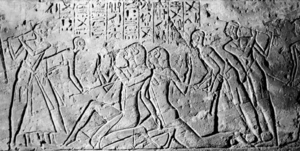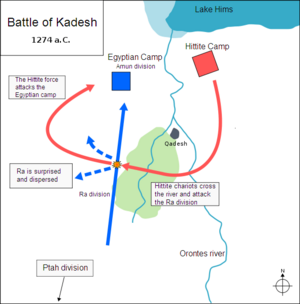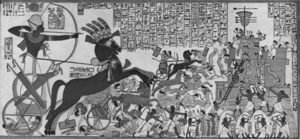Battle of Kadesh facts for kids
Quick facts for kids Battle of Kadesh |
|||||||
|---|---|---|---|---|---|---|---|
| Part of the second Syrian campaign of Ramesses II | |||||||
 Depiction of Ramesses II slaying one enemy while trampling another, from a rock-cut relief at Abu Simbel |
|||||||
|
|||||||
| Belligerents | |||||||
| New Kingdom of Egypt | Hittite Empire | ||||||
| Commanders and leaders | |||||||
Ramesses II
|
Muwatalli II
|
||||||
| Strength | |||||||
|
20,000–53,000 troops (half engaged)
|
23,000–50,000 troops
|
||||||
| Casualties and losses | |||||||
| Unknown (presumed heavy) | Unknown (~2,000 chariots destroyed) | ||||||
The Battle of Kadesh was a huge fight that happened a very long time ago, around 1274 BC. It was a clash between two powerful empires: the Egyptian Empire, led by the famous pharaoh Ramesses II, and the Hittite Empire, led by King Muwatalli II.
Their armies met near the Orontes River, close to a city called Kadesh. This area is now near the border between Lebanon and Syria. This battle is special because it's the earliest one in history where we know a lot about the battle plans and how the armies were set up. It's also thought to be the biggest battle ever fought using chariots, with possibly 5,000 to 6,000 of them!
Even though Ramesses II's army was tricked and ambushed, he personally led a brave charge. This helped turn the tide of the battle. Most historians agree that the battle ended in a tie, or a "stalemate."
Contents
Why the Battle of Kadesh Happened
Egypt's Desire for Control
After getting rid of the Hyksos rulers around 1550 BC, the Egyptian New Kingdom wanted to control its borders again. Pharaohs like Thutmose I and Thutmose III fought many battles in areas like Canaan and ancient Syria. They wanted to expand their empire.
Over time, Egypt's power in these northern regions weakened. The Amarna letters, which are ancient diplomatic messages, show this decline. However, by the time of Horemheb, the last ruler of the Eighteenth Dynasty, Egypt started to show interest in these lands again.
Ramesses II's Goals
Seti I, Ramesses II's father, was a military leader who worked hard to bring back Egypt's former glory. He led armies into Canaan and ancient Syria, taking back cities and setting up garrisons. He even captured Kadesh at one point.
Ramesses II, who was a prince then, fought alongside his father. He continued this mission. In the fourth year of his rule, he marched north into Syria. He wanted to make sure his allies were still loyal and to explore the land for future battles.
The main reason King Muwatalli II of the Hittites marched south was to get back control of a region called Amurru. This area was important to both empires.
The Armies and Their Strengths
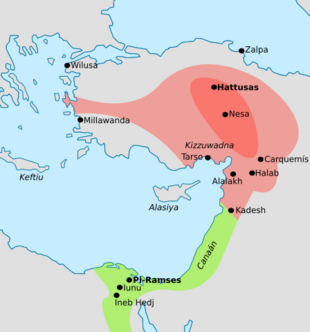
Egyptian Forces
Ramesses II led a large Egyptian army. It was divided into four main groups, named after important Egyptian gods:
- The Amun division
- The Re (or Ra) division
- The Set division
- The Ptah division
There was also a special group called the Ne'arin (or Nearin). These were likely soldiers from Canaan who fought for Egypt, or perhaps even Egyptians. They played a very important role in the battle.
Another key group was the Sherden troops. These were skilled fighters who worked as mercenaries for the Egyptians. This was one of the first times they appeared in Egyptian records.
Historians believe the Egyptian army had at least 2,000 chariots. Each division probably had about 500 chariots. These chariots were lighter and faster than the Hittite ones, which became important during the battle.
Hittite Forces and Allies
King Muwatalli II of the Hittites brought together a huge army. He had many allies from different kingdoms. Ramesses II's records list 19 different allies who fought with the Hittites at Kadesh. This list helps historians understand how far the Hittite Empire's power reached at that time.
Some of the important allies included:
- The kingdom of Aleppo in Syria
- The kingdom of Ugarit in north Syria
- The Kaska people from northern Anatolia
The Hittite army was also very large, with thousands of infantry (foot soldiers) and many chariots. Their chariots were heavier and carried three men, making them slower but perhaps more powerful in a direct charge.
The Battle Unfolds
The Hittite Trick
Muwatalli, the Hittite king, cleverly hid his army behind "Old Kadesh." Ramesses, however, was tricked by two captured nomads. These nomads were actually Hittite spies! They told Ramesses that the Hittite army was far away, near Aleppo.
Believing this false information, Ramesses ordered his army to set up camp. He then rushed ahead towards Kadesh with only his advance guard, completely unaware that the huge Hittite army was waiting very close by.
The Ambush
As Ramesses and his advance group were about 11 kilometers from Kadesh, they met two more nomads. These new nomads were Hittite prisoners. They told Ramesses the truth: the entire Hittite army, with their king, was hidden right behind Kadesh!
Ramesses was very upset that his officials hadn't found this out sooner. He quickly called his princes to discuss what to do. He ordered the Ptah and Set divisions to hurry up and join them. The Re division was already close.
While Ramesses was preparing, the Hittite chariots suddenly attacked! They crossed the river and crashed into the middle of the Re division, which was still on its way to the camp. The Re division was caught by surprise and scattered. Many fled towards Ramesses's camp, with Hittite chariots chasing them.
Ramesses's Brave Stand
The Hittite chariots then turned north and attacked the main Egyptian camp. They broke through the Amun division's defenses, causing panic. However, the Hittite attack started to slow down because the camp was full of obstacles. Some chariots even crashed.
In the Egyptian story, Ramesses said he was left alone, surrounded by enemies: "No officer was with me, no charioteer, no soldier of the army, no shield-bearer."
But Ramesses II was incredibly brave. He personally led several charges against the Hittite forces. His personal guards, some chariots from his Amun division, and survivors from the scattered Re division joined him.
The Hittites, thinking they had won, had stopped to loot the Egyptian camp. This was a big mistake! They became easy targets for Ramesses's counterattack. He pushed the looters back towards the Orontes River. His lighter, faster Egyptian chariots easily caught up to the heavier Hittite chariots.
The Tide Turns
Even after this, King Muwatalli II still had a large group of reserve chariots and foot soldiers. He ordered another thousand chariots to attack. But then, something unexpected happened: the Ne'arin troops, who had been left in Amurru, suddenly arrived! They surprised the Hittites from the side.
Finally, the Ptah division arrived from the south, threatening the Hittite army from behind. After six charges, the Hittite forces were almost completely surrounded. The remaining Hittite soldiers had to abandon their chariots and try to swim across the Orontes River. Many drowned.
Aftermath of the Battle
A Stalemate
Ramesses II declared that he had won the battle. However, he couldn't capture the city of Kadesh. He gathered his troops and went back south to Egypt. The battle was a personal victory for Ramesses because he managed to rally his troops and save the day after being ambushed. His new, lighter chariots proved to be better at chasing down the heavier Hittite chariots.
Hittite records, however, tell a different story. They suggest that Ramesses was forced to leave Kadesh in defeat. Most modern historians agree that the battle ended in a draw. It was a turning point for the Egyptians, who had developed new ways of fighting and were pushing back against the Hittites.
The Peace Treaty
After the battle, the Hittite king Muwatalli II continued to fight in the region. Egypt's influence in Asia was limited to Canaan. Ramesses had to fight more battles to keep control of Canaan.
In the eighth and ninth years of his rule, Ramesses had more military successes. He captured Hittite cities like Dapur and Tunip. But these victories didn't last long. Neither Egypt nor the Hittites could completely defeat the other in this area.
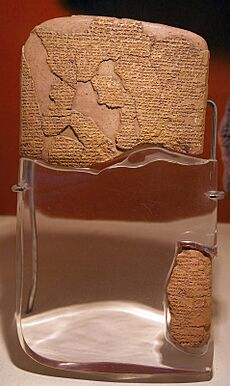
Finally, about 15 years after the Battle of Kadesh, a peace treaty was signed. This happened in the 21st year of Ramesses II's reign (1258 BC) with the new Hittite king, Hattusili III. This treaty officially ended the fighting over the borderlands.
The treaty was written on a silver tablet. A clay copy of it was found in the Hittite capital, Hattusa, which is now in Turkey. You can see it on display at the Istanbul Archaeology Museum. A large copy of this treaty hangs at the United Nations headquarters. It's considered the earliest known international peace treaty!
How We Know About Kadesh
Egyptian Records
We have more information about the Battle of Kadesh than almost any other battle from the Ancient Near East. However, most of this information comes from the Egyptian side.
The main Egyptian records are called the Poem and the Bulletin. These are long descriptions of the battle, often repeated many times on temple walls in places like Abydos, Temple of Luxor, Karnak, Abu Simbel, and the Ramesseum. While these records give us many details, historians know that Ramesses II's version is also a form of propaganda, making him look very heroic.
Hittite Records
Hittite records about the battle have been found in Hattusa. These records don't describe the battle in detail like the Egyptian ones, but they mention it in relation to other events. For example, for Hattusili III, the battle was an important moment in his life.
Images for kids
See also
- Chariotry in ancient Egypt
- Egyptian–Hittite peace treaty
- Battle of Megiddo



